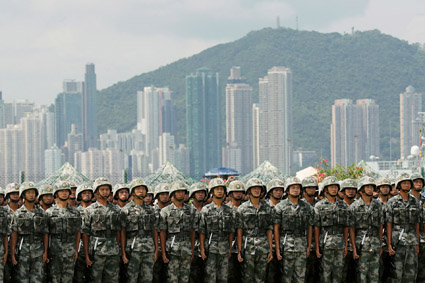Last month, Beijing moved thousands of troops across the border into this restive city. They came in on trucks and armored cars, by bus and by ship.
The state news agency Xinhua described the operation as a routine “rotation” of the low-key force China has kept in Hong Kong since the city’s handover from Britain in 1997. No mention was made of the anti-government protests that have been shaking the metropolis since June.
It was a plausible report: China has maintained a steady level of force in the territory for years, regularly swapping troops in and out. And days earlier, according to an audio recording obtained by Reuters, embattled Hong Kong leader Carrie Lam had told local businesspeople that China had “absolutely no plan” to order the army to put down the demonstrations.
A month on, Asian and Western envoys in Hong Kong say they are certain the late-August deployment was not a rotation at all, but a reinforcement. Seven envoys who spoke to Reuters said they didn’t detect any significant number of existing forces in Hong Kong returning to the mainland in the days before or after the announcement.
Three of the envoys said the contingent of Chinese military personnel in Hong Kong had more than doubled in size since the protests began. They estimated the number of military personnel is now between 10,000 and 12,000, up from 3,000 to 5,000 in the months before the reinforcement.
As a result, the envoys believe, China has now assembled its largest-ever active force of People’s Liberation Army (PLA) troops and other anti-riot personnel and equipment in Hong Kong.
Significantly, five of the diplomats say, the build-up includes elements of the People’s Armed Police (PAP), a mainland paramilitary anti-riot and internal security force under a separate command from the PLA. While Reuters was unable to determine the size of the PAP contingent, envoys say the bulk of the troops in Hong Kong are from the PLA.
PAP forces would be likely to spearhead any crackdown if Beijing decides to intervene, according to foreign envoys and security analysts. These paramilitary troops are specially trained in non-lethal tactics and methods of riot suppression and crowd control.
The envoys declined to say how exactly they determined that the recent troop movement was a reinforcement or how they arrived at their troop estimates. Reuters reporters visited the areas surrounding multiple PLA bases in Hong Kong and observed significantly increased movements by troops and armored vehicles at the facilities.
China’s Ministry of National Defense, the PLA garrison in Hong Kong, the State Council Information Office, and the Hong Kong and Macau Affairs Office did not respond to questions from Reuters. In early September, a spokeswoman for the Hong Kong and Macau Affairs Office said China would “not sit idly by” if the situation in the city continued to deteriorate and posed a threat to “the country’s sovereignty.”
The office of Carrie Lam had no comment. A Hong Kong police spokesperson told Reuters the police force was “capable of maintaining law and order and determined to restore public safety in Hong Kong.”
After this story was published, Lawrence Li, spokesman for the Hong Kong government’s Security Bureau, issued a statement saying the PLA garrison is operating “in strict accordance” with the law. “Details of the Garrison’s rotation, including the number of its members involved, are defence matters,” he wrote, and the government “has no relevant information to provide.”
The PAP is a key element in Chinese leader Xi Jinping’s drive to reinforce the ruling Communist Party’s control over the nation of 1.4 billion people while building a potent military that can supplant the United States as Asia’s dominant power. The PAP has up to one million troops, according to an April research paper from the U.S.’s National Defense University – about half the size of China’s standing military. The paramilitary’s primary duty is to defend against potential enemies within – countering domestic upheaval and protecting top leaders. In recent years, it has contained unrest in Xinjiang and Tibet. Elements of this force are also trained for counter-terrorism, securing key infrastructure, disaster relief and international peacekeeping.
After installing himself as commander-in-chief and reshaping the regular military, Xi turned attention to the PAP. His first move was to take personal control. In early 2018, the PAP was brought under direct command of the Central Military Commission, the top military decision-making body that Xi chairs. Previously, the PAP had come under the split command of the commission and the State Council, China’s top government administrative body.
This put Xi at the apex of Beijing’s military and paramilitary forces, further concentrating power in his hands. With the eruption of the protests in Hong Kong, however, Xi now faces the biggest popular challenge to his rule.
News of the reinforcements in Hong Kong comes as city officials are bracing for more demonstrations on Tuesday, Oct. 1, the 70th anniversary of the founding of the People’s Republic of China. Intense clashes between protesters and police rocked the city over the weekend ahead of the celebrations.
In her private remarks in August, city Chief Executive Lam played down the possibility that Beijing might deploy the PLA. Foreign envoys and security analysts said they too believe China’s strong preference is not to use troops.
Still, they said, the troop build-up shows Beijing wants to be ready to act if the Hong Kong government and its 30,000-strong police force lose control of the city. Lam herself expressed concern about the force’s ability to keep control. On some days, hundreds of thousands of demonstrators have taken to the streets. She said the police are “outnumbered” by the protesters, making enforcement “extremely difficult.”
“Apart from the 30,000 men and women in the force we have nothing,” she told the gathering of businesspeople. “Really. We have nothing. I have nothing.”
Submission – By GREG TORODE, JAMES POMFRET and DAVID LAGUE
Source: Reuters


